Larvae of the Outer Gods
Strange creatures, half dreamed half imagined, figments of delerium, wisps of insanity.
The Larvae of the Outer Gods
Rather to the contrary, the larvae of the outer gods are not the spawn of eldritch and ancient beings, not really part of their reproductive cycle as such immense and ancient creatures do not constitute something as small as a race, and each is in and of it's own a unique thing. Much as a human sheds dead skin, sweat, hair, and the rest of the list of excrements, so do the outer gods cast off parts of themselves, with the same amount of thought given to the shed material as a person thinks of the dust they shed. But being outer gods, their detritus isn't the same as dead skin and expelled mucus, their cast offs are composed of primordial ephemera, alien energy, and can be physical, incorporeal, hyperdimension, or possessing a single dimension.
Larvae share many common characteristics, they are extremophiles and can survive indefinitely in almost any environment. They do not require a specific atmosphere, gravity, protection from radiation, food, or any of the other requirements of standard biological life. These mindless creatures exist much like single celled organisms, possessing at best a rudimentary urge to consume but nothing of intellect. They retreat from pain, attack things that seem like food, but cannot communicate, do not have thoughts, ideas, imaginations, and many do not even have any sort of coherent form, and those that do are made from the same stuff as nightmares. Larvae can be found in any environment ranging from deep sea to the vacuum of space, from frozen rocks to the outer layers of stars, and there is no reason that such creatures cannot exist even within the furnaces of stars.
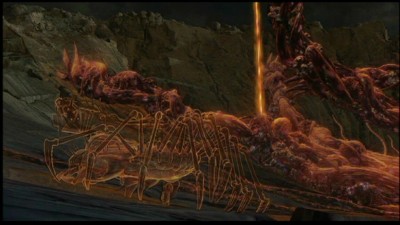
Life Cycle
The Larvae of the outer gods spend most if not all of their existence in the earliest stages of their embryonic cycle. They drift mindlessly through the cosmos, blithely ignoring things like gravity, radiation, or even the intervening mass of a planet or star as they move like plankton, but suspended in a sea that only they can perceive and interact with. On rare chance, a larvae will be drawn to a specific place and will manifest there, interacting with the physical world, and becoming a solid entity. Once settled, it will begin a path of growth and consumption. Given enough time, these manifested larvae can reach truly gargantuan size, hundreds of feet long, or tall, depending on their body layout. Should one of these manifest on an inhabited world, it will attempt to devour everything on said world until it has either succeeded or is destroyed.
The growth of a larvae is not a sure thing, once manifested, the larvae loses many of it's previous advantages and becomes subjected to the environment it has manifested in. It can be killed by predation, accident, or by deliberate force, as there are races that sweep through their sections of the cosmos exterminating these pests when they appear. It is far easier to eliminate the larvae when they are small. Once they reach the size of buildings and mountains, it becomes much more difficult.
After enough eons have passed, a larvae has the potential to begin developing an intelligence, a will beyond the impulse to explore, consume and grow. Once this occurs it is a relatively short amount of time, a few million years, that the being will transcend and rise into the aether as a new outer god. These newborn outer gods will begin the long trek back to find their creator, the being that shed their initial corpus billions of years before. Some abort this trek, and become alien gods over inhabited worlds, shaping the resident species to suit them, or to worship them, or will simply continue drifting, devouring world after world until they are lost from the edge of existence, consume themselves out of hunger, or are confronted and destroyed by other outer gods.
This paragraph is included only for academic purposes as the existence of humanity has been less than the passing of an eyeblink to the larvae of the outer gods.
Minor Larvae (Small)
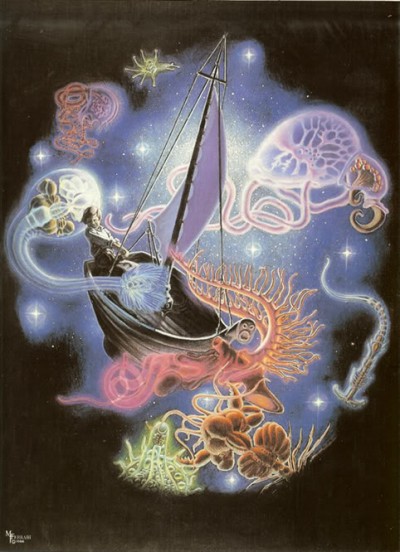
Minor threats, small larvae are seldom more than a few feet in their longest dimension. These entities are very primitive in structure and resemble diatoms, embryonic forms of insects and such, jellyfish like creatures, or massive versions of single cell organisms, They drift and when one of these larvae manifests, it typically retains its limited ability to hover and move within it's general space.
Examples: bugs, worms, floaters, and other creatures roughly the size of a large dog. These larvae are still largely undifferentiated material, and can exhibit biomorphism, changing shape, body pattern, and so on, until they mutate into something viable. Dealing with these creatures isn't difficult as though they can defend themselves, often with stingers, tentacles, claws, strange secretions, acids, and poisons, they are not horribly tough. A hard stomp from a boot, or a shot from a pistol can kill one. An innoble end for a creature with the potential to become a new god.
Standard Larvae (Medium)
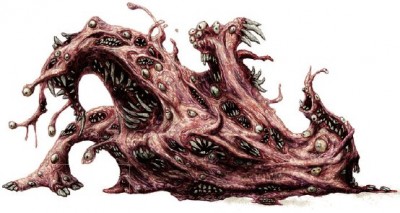
A more direct threat, a medium sized larvae is able to kill and consume an unarmed, unprepared human. The medium larvae starts much like it's minor sized companion, with the same highly variable bag of innate abilities and invulnerabilities. The medium larvae is stronger, and tougher, by virtue of its size, and at this point, it has set it's general layout. If it looks like a crab, its going to stay generally crab like, unlike the minor larvae which can look like a floating diatom, or a squid, or anything inbetween.
The medium larvae is the most common size encountered, and is generally considered 'standard' and while dangerous, they are still not intelligent, and they do not make plans, or lay traps. It isn't uncommon for more than one larvae to manifest in the same place in the same general timeframe. These creatures do not recognize each other, and will coexist only as long as there are other things for them to consume. Once that is gone, they will turn on each other until only one remains, or the last two succumb to injury. At this point, it isn't uncommon for the one trick pony of the minor larvae to have developed 2-3 innate abilities.
Variation: The Bug Hunt, rather than evolving and growing larger, a larvae can become a dead end, and begin reproducing more copies of itself. These copies will expand outwards, hunting, destroying and consuming until they have eliminated everything that is not them. In this process, the larvae will mutate and functionally pupate into a new species, drawing on the metaphysical aspect of it's divine nature and the biological aspect of what it consumed. The final question: is intelligent life the end effect of biological evolution, the hand of a divine creator, or an accident of a divine macrophages assimilating and replacing a promising animal species? What did ever happen to the Neanderthals?
Large Larvae (Large)
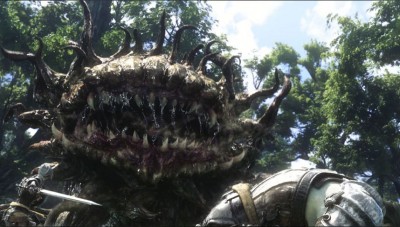
The successful, or large larvae that manifests is an impressive creature, as large as a horse or regular automobile, it demonstrates the bioplasticity of it's smaller kin, but it's path is set, and its evolutionary/mutational design is done. A spider like larvae will if it survives, become a spider shaped god. The large larvae is still a mindless creature, but it has become focused in it's design and intent. As this point, the larvae is able to begin it's own primitive form of procreation and will begin casting off miniature versions of itself. Unlike the cul-de-sac mentioned in the medium larvae these are not the end of the creature, but represent a more efficient method of feeding. The swarming creatures are minor larvae in form, but cannot grow any larger than medium size, and have only the lesser abilities of the parent creature that laid them, budded them off, or implanted them in whatever host it found.
The large larvae is a dangerous threat as it is starting the generate a host to protect itself. It is also absorbing everything it can, and if it begins consuming intelligent prey, it can fast track it's growth, and mental development. Dealing with large larvae requires powerful magic, heavy weapons, or other similar countermeasures.
Super Larvae (Huge)
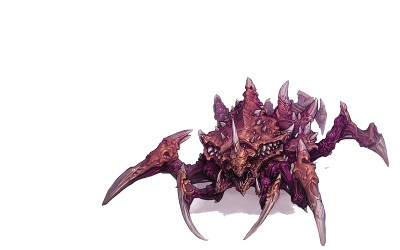
The super larvae is a large and dangerous threat, requiring teamwork, and massive firepower, magical or technological, to overcome. Super larvae have demonstrated the ability to survive and thrive in their adopted environment, and while they only have one or two more innate abilities than their medium sized kin, they are much larger, much tougher, and are able to deal out much more damage when threatened. The super larvae has likely decimated most of it's immediate surroundings, and has spawned a host of small and medium servitors in it's quest to devour all.
The super larvae can be contained, forced into a dormant state, or destroyed with serious effort. In some areas, such beasts can be placated with prayer and ritual sacrifice which will sustain the creature and temper it's hunger, leaving it to exist as a massive beast god. Lacking the full ability to destroy a super larvae is isn't uncommon for a race to build a massive trap to draw a larvae in, bind it with magic or seriously wound it, and then bury it deep in the ground.
Mega Larvae (Gargantuan)
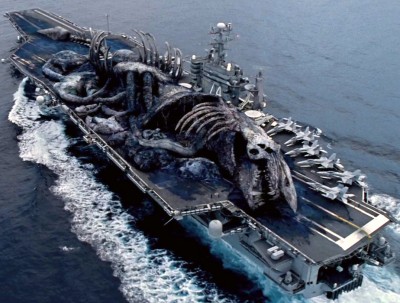
Mega Larvae as massive, hundreds of feet in dimension and their weight soars into the the thousands of tons. These creatures have likely consumed a large portion of the biomass of the planet they settled on, have become petty gods or scourges to those that survived their appearance, and are nigh invincible behemoths. This being said, the larvae is still largely a mindless brute, and very few ever reach this level of power. Most are destroyed, fail to thrive, or happen to manifest in an area lacking enough material to grow to large size.
Mega larvae are rare, and are prone to long periods of dormancy, especially when still developing and presented with a limited food supply. Rather than completely wipe out everything it isn't uncommon for a mega larvae to simply go into a passive hibernation for several tens of thousands of years to a few hundred thousands of years to awake and again ravage their infested biosphere.
Inspirations and Plot Hooks
Pacific Rim (2013) - the aliens on the other side of the bore have found a way to capture larvae of the outer gods, and have mastered their own alien biotechnology to the point that they can accelerate the growth of larvae, guiding it, to create mindless tactical bio-super weapons.
Godzilla (various) - rather than being radiovores, the various sundry monsters of the venerable kaiju franchise can be described as mega larvae, either mutated with Godzilla cells, or under the influence of an alien culture.
Cloverfield (2008) - As above, the titular monster is a mega larvae, demonstrating juvenile characteristics, while shedding parasites that on their own are a dangerous threat as small and medium spawn.
Final Fantasy X (2003) - Spira struggles with a massive mega larvae that is actively hunting with the intent of devouring their planet, complete with spawn, spread disease and taint in it's wake. Where the above entrants fight the monsters with guns, lasers, and giant robots, the Spirans fight with ritual magic.
Starcraft (1998) - The Zerg are poster children for the larvae of the outer gods, with their relentless biological imperative to consume and assimilate everything in the universe. The hive mind itself is what a mega larvae, immobile for millenia, would become as it developed intelligence. It's spawn spread out as it grows, and struggles with the urge to remain a corporeal monster or transcending into the aether as a nascent God.
Warhammer 40K, the Tyranids (1987) - the entire concept of mycetic assault, seeding a world with spores that grow into monsters is pretty much the meat and potatoes of the larvae of the outer gods, albeit on a much higher scale.
Not Registered Yet? No problem.
Do you want Strolenati super powers? Registering. That's how you get super powers! These are just a couple powers you receive with more to come as you participate.
- Upvote and give XP to encourage useful comments.
- Work on submissions in private or flag them for assistance.
- Earn XP and gain levels that give you more site abilities (super powers).
- You should register. All your friends are doing it!
? Responses (7)
Great categorizations of them. Very easy to take this and throw it in a game and have a basic understanding of all the types. Fun concept.
The creature you are chopping up would otherwise be a god or goddess. 5/5
Keep in mind that this is Lovercraft/Call of Cthulhu, so the gods and goddesses are much more wads of viscera, tentacles, and madness inducing horrific amalgams of strange varieties and unknown types of creatures.
These things feel almost like something out of Men-in-black. A category of enemy to be hunted by the organization. Could fit in many different genres.
Great categorization. Ranking and organizing unfathomable monsters seems an attempt to tame them with our words, no matter how feeble that attempt may be.

It may be a feeble attempt, but by the same token, it does provide at least a framework to shape our thoughts and give guidelines to work with.
